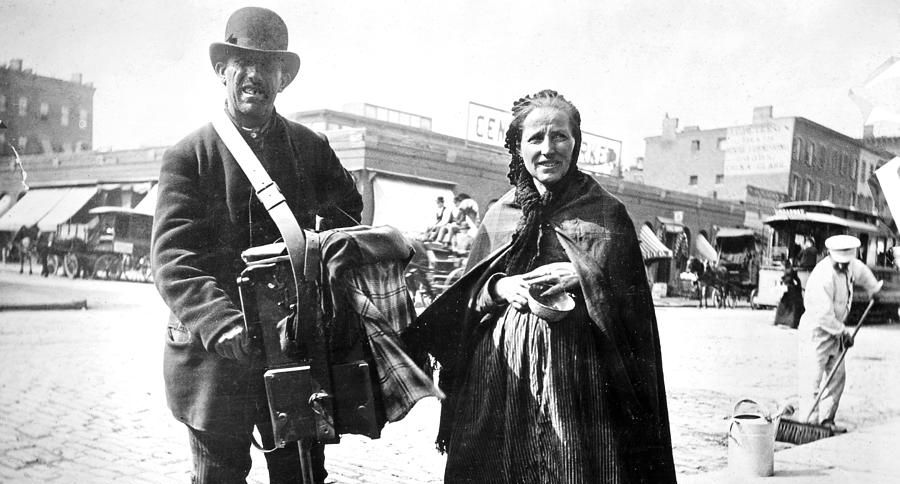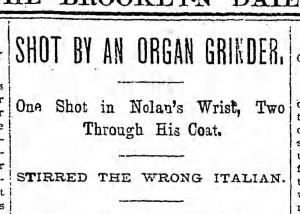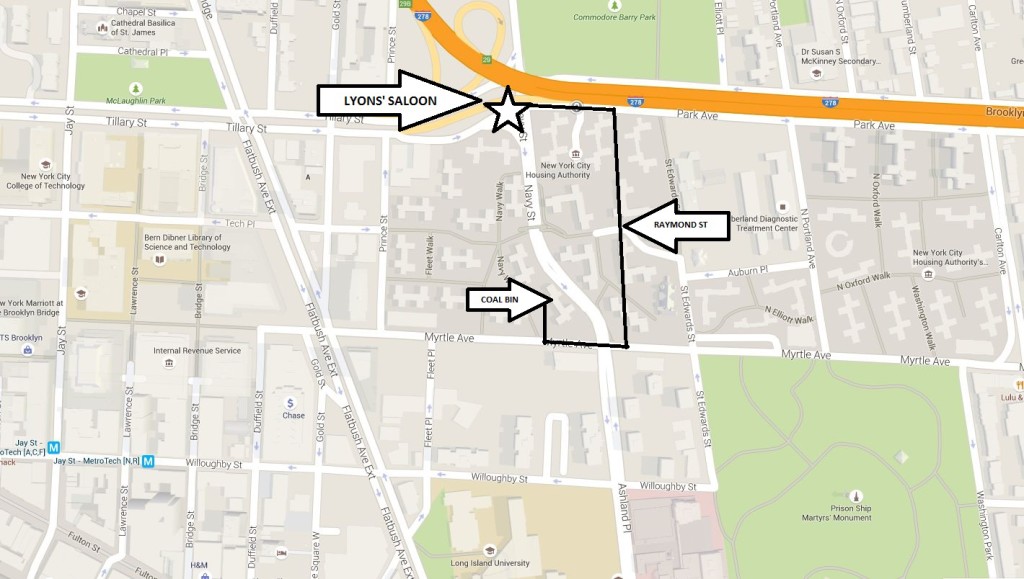SHOT BY AN ORGAN GRINDER (1895)

Brownstone Detectives investigates the history of our clients’ homes.
The story you are about to read was composed from research conducted in the course of one of those investigations.
Do you know the history of YOUR house?
********************************************************************************************************************************
Two things can be said of most 19th century Brooklyn organ grinders – they were rarely accompanied by monkey assistants, and they were chiefly non-violent types.

As romantic a figure as they are to us today, though, they were not altogether loved by the citizens of their time. Many found the “music” of their hand organs to be grating and and an unforgivable breach of the peace.
By and large, most were harmless poor Italian men simply plying their trade in order to bring in a meager living – usually to feed a large family.
One morning, though, in December of 1895, the tune of one grinder did not present as sonorous music to the ears of a rising Brooklynite, and in the process this resident found that, attempting to prevent the strains of a lilting ballad, he had “stirred the wrong Italian.”
OUTSIDE A BAR ON AN EARLY MONDAY MORNING
Michielo Geraso, accompanied by another Italian with a hand organ, appeared in front of the saloon of Bernard Lyons on Tillary street at about 9:30 a.m. Geraso’s companion turned the organ crank while Geraso “made ready to collect money.” The organ had scarcely tuned up when the Italians were ordered to move on.
Lyons’ saloon was closed on account of the death of his infant daughter, noted the Brooklyn Daily Eagle, and it was Thomas Nolan, so the neighbors say, who on Lyons’ behalf appeared at the door and ordered the Italians away.
Nolan claims that Geraso, without any further provocation, pulled the revolver from his hip pocket and began “blazing away.”

THE CHASE
Officer George Danzglock, on a crosstown car on his way from the police headquarters at the time, jumped from the car and gave Geroso chase.
He followed him through Tillary street to Raymond Street, to Myrtle Avenue and back to Navy street. Here, Geroso disappeared in a hallway a short distance above Myrtle avenue.
The officer followed and after a search found him in a coal bin under a stairway. He had covered himself with the coal and was almost hidden from view, with the exception of a small portion of his head.
The officer, fearing that he might be fired upon, drew his revolver and placed it at Geroso’s head.
At this point Geraso was arrested and brought to the station house and searched. But no pistol was produced. Geraso claimed he had never had one.
THE ARRAIGNMENT
At the arraignment, Geraso pled not guilty to firing three shots, one of which went through Nolan’s wrist.
Through the court interpreter Geraso stated that after Nolan ordered him away he (Nolan) struck him with his fist on the eye. Nolan, who was in the court, denied striking the man, but a witness said he saw Nolan place his hand on Geroso and endeavor to compel him to move away.
Geraso also claimed that he was not in front of Lyon’s saloon, but was serenading a friend who had lately been married. The organ grinder who was with Geraso disappeared during the excitement following the shooting and had not been located.
It was learned that the other two shots fired went through Nolan’s coat. It was a mystery, a newspaper account noted, “how he escaped serious if not fatal injury.”
The three men in this story must have been familiar with one other as they all lived within a few houses of each other. Nolan and the Lyons were both at No. 92 Navy Street, and Geraso, at No. 102 Navy Street.
It is entirely possible that Nolan and Geraso had had words with one another before and that the stories they both told were partial truths – if not constructed entirely from whole cloth.
THE DEVIL IN THE DETAILS
Much of this story is mired in a sort of xenophobia which gave more credence to the stories that were told by those subjects who had Anglo-Saxon sounding names. Although Nolan was of Irish ancestry, he was still further up the ladder than the Italians of the time, thus receiving the benefit of the doubt in determining what actually happened during the engagement.
Additionally, newspapers of the time were not restrained by the truth. Their reporters casually littered their stories with inaccurate details and passed their articles through the filters lined with stereotypes and biases.
The story about Lyons’ infant daughter was likely true, although it is reported in the New York Herald that the death occurred to his son, Eddie, who was taken with pneumonia the morning before this occurrence. Also, the Herald identified “The Italian” as “Michelo Cesareno,” not “Michelo Geraso.” Further information was also given about Nolan in this paper, as it identified him as a liquor dealer who operated from High Street.
Ironically, the New York Evening Post further contributed its “evidence,” noting that Nolan lived just two houses away from “Gesaro” at No. 102 Navy Street. It also noted that Lyons’ infant son lay dead upstairs in the apartments above the saloon. It further noted that the second shot fired had grazed Nolan’s shoulder, while the third had lodged in the “fleshy part of the back.” Also, in the Post’s version of the story, Nolan was Lyons’ bartender.
———————————————————————————————————————–
 Brownstone Detectives is an historic property research agency. Our mission is to document and save the histories of our clients’ homes. From our research, we produce our celebrated House History Books and House History Reports. Contact us today to begin discovering the history of your home.
Brownstone Detectives is an historic property research agency. Our mission is to document and save the histories of our clients’ homes. From our research, we produce our celebrated House History Books and House History Reports. Contact us today to begin discovering the history of your home.